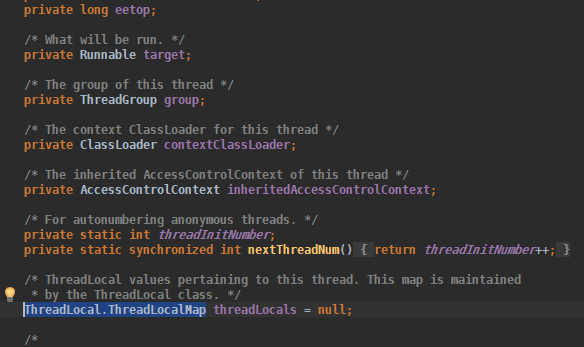初探ThreadLocal
在使用spring boot的时候,发现这么样一个很有意思的功能:
RequestContextHolder.getRequestAttributes()).getRequest()
可以通过这么样的一个类来获取当前的Request对象,第一反应就是spring boot替我们完成了request对象与当前线程的绑定。
那这内部,又是如何实现的?

这个RequestContenxtHolder里面有一个ThreadLocal对象,这个对象,就是实现数据与线程绑定的核心对象。
那么ThreadLocal又是什么?

从源码的注释大概可以了解到,这个类可以用来实现线程本地变量,我们来做个试验:
public class Main{
private ThreadLocal<String> threadLocal = new ThreadLocal<>();
public void set(String str){
threadLocal.set(str);
}
public String get(){
return threadLocal.get();
}
public static void main(String[] args) throws InterruptedException{
Main main = new Main();
main.set("hello");
Thread thread = new Thread(()->main.set("world"));
thread.start();
thread.join();
System.out.println(main.get());
}
}
当运行这个程序的时候,会输出什么?
结果是hello,由于thread线程肯定是会在set(“hello”)之后,join()之前运行完毕的,所以我们可以从这个小例子当中初步了解ThreadLocal的用法。
那么我们知道,在JAVA内存模型当中,分为公共内存和线程私有内存,或者也叫工作内存。
线程私有内存是在栈上,那么我们能不能据此判断,ThreadLocal对象是在栈上?
继续看源码:
set方法:
public void set(T value) {
Thread t = Thread.currentThread();
ThreadLocalMap map = getMap(t);
if (map != null) {
map.set(this, value);
} else {
createMap(t, value);
}
}
get方法:
public T get() {
Thread t = Thread.currentThread();
ThreadLocalMap map = getMap(t);
if (map != null) {
ThreadLocalMap.Entry e = map.getEntry(this);
if (e != null) {
@SuppressWarnings("unchecked")
T result = (T)e.value;
return result;
}
}
return setInitialValue();
}
getMap方法:
ThreadLocalMap getMap(Thread t) {
return t.threadLocals;
}
从这三个方法来看,线程对象内部有一个ThreadLocal.ThreadLocalMap对象:

正是通过这个map,才实现了线程与数据的绑定。